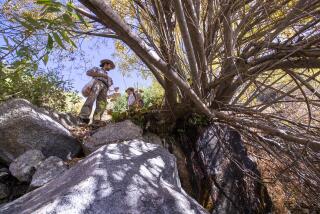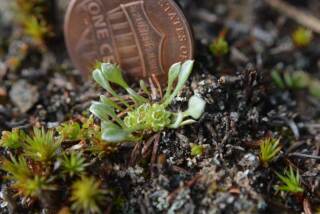Scientists Seek to Save Rare ‘Relic’ Plant
- Share via
MT. WASHINGTON, N.H. — Thin shards of stone clinking under foot, researcher Brian Fitzgerald hiked up the wind-punished ridge in pursuit of the world’s last patch of Robbins cinquefoil.
Fitzgerald stepped atop large, flat stones, searching the barren landscape for the dime-size blossoms of the Alpine plant amid the moss-dappled rocks. Finally, in the shelter of a small terrace, Fitzgerald found the flowered plant--the last to blossom this summer.
“The plants will survive, but to measure success, they have to thrive,” said Fitzgerald, the howling winds muffling his words and reddening his face to nearly the color of his hair.
An estimated 1,400 Robbins cinquefoil adults are known to exist, all of them atop the lunar-like landscape of one of the fiercest environments in the world: 6,288-foot Mt. Washington. The distinction earned the plant a place on the federal endangered species list in 1980.
‘Relic’ Plant
Now environmentalists and Forest Service officials hope to preserve and help multiply what one researcher calls a “very weird species” of a “relic” plant.
While one of the world’s rarest plants has survived the incessant winds and weather extremes of the Northeast’s highest mountain, it was man who nearly drove Potentilla robbinsiana --the plant’s botanical name--into extinction.
Botanists added the rare plant to their collections and thinned the species since James Robbins discovered it in 1829. More recently, hikers have trampled the tiny plants.
From its original four locations in the Presidential Range, the cinquefoil now has been reduced to the Mt. Washington colony, several hundred feet from the Lakes-of-the-Clouds hut operated by the Appalachian Mountain Club.
The delicate plant grows in a one-acre preserve shielded by a low rock wall from curious hikers. The Crawford Path, one of the trails maintained by the Appalachian Mountain Club, was moved several hundred feet this decade to divert hikers from the terraced grounds.
U.S. Forest Service signs warn at the perimeter of the hallowed ground: “No admittance allowed without a permit.” Violators are subject to fines of up to $500.
“Amateur botanists wanting to go into the area is our biggest problem,” said Roger Collins, the U.S. Forest Service worker who oversees the “forbidden zone,” as the colony has been dubbed by researchers. He said most hikers who wander into the area do so unwittingly and benignly.
Location Kept Secret
Ken Kimball, the AMC’s research director, said a recovery plan developed by forest and wildlife officials seeks to reduce the threats to the plant’s existence, to better understand its biology and to establish new colonies.
The location of the transplants is being kept secret to protect the delicate plants.
“Our problem is, anything that is rare is desired for some reason,” he said.
Kimball said the Robbins cinquefoil is an interesting botanical subject, regardless of its numbers.
“It turns out this is a very weird species as far as its genetics goes,” Kimball said. He said its reproductive system dates to “when the glaciers were down here--9,000, 10,000 years ago.
Although the Alpine plant occupied a much larger area decades ago, Kimball said it is unlikely that Robbins cinquefoil will ever multiply over a much greater range, even if the recovery program is a success.
“Our objective never has been to make it a widespread species, because it never was,” he said. “It is a species that is a relative poor competitor with other species . . . that lives in a harsh environment because it only has to compete with a few other species.”
Early visitors to Monroe Flats, where the colony is located, have described the terrain as “essentially sterile” and “utterly barren.” Winds blast the ridge and weather extremes heave the soil.
Grows Low to Ground
Like other tightly bunched vegetation and runt pines that barely thrive above the tree line, the cinquefoil grows low to the ground to shield itself from the constant winds. The world’s highest winds ever--231 m.p.h.--were recorded up the boulder-strewn trail to the summit of Mt. Washington.
“They’ve adapted to the climatic conditions, but they haven’t been able to withstand humans,” Collins says. He says the eventual goal of the program is to get the plant “unlisted on the endangered species list.”
More to Read
Sign up for Essential California
The most important California stories and recommendations in your inbox every morning.
You may occasionally receive promotional content from the Los Angeles Times.













